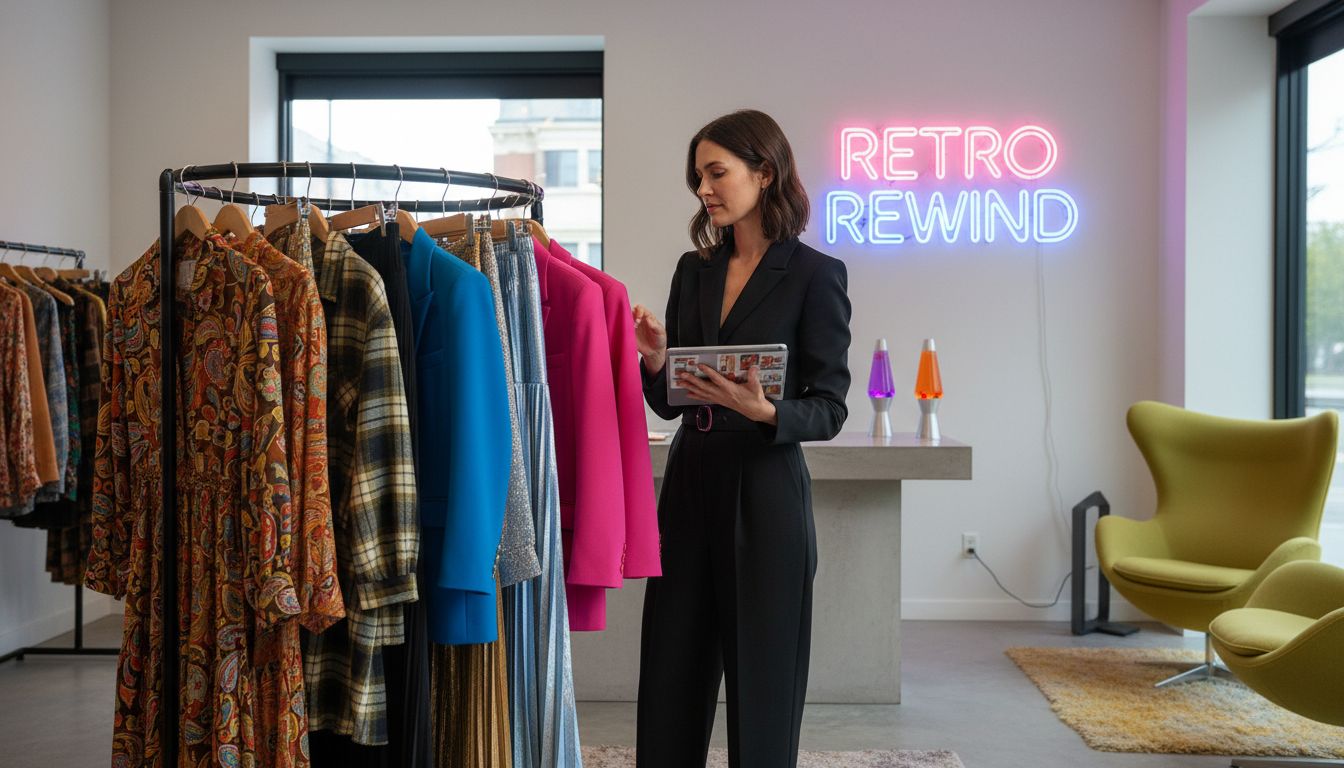Fashion trends will always come full circle, but did you know that over 60 percent of Gen Z shoppers prefer retro-inspired pieces over brand-new styles? Retro clothing catches the eye because it weaves together decades of culture, art, and self-expression. Today, bold colors, playful patterns, and nostalgic details breathe new life into online and streetwear scenes, offering a creative way to stand out with a story stitched into every look.
Table of Contents
- Defining Retro Clothing Style Today
- Popular Eras and Retro Fashion Trends
- Key Elements of Retro-Inspired Apparel
- How Retro Style Influences Modern Graphics
- Retro Style Vs. Vintage and Revival Clothing
Key Takeaways
| Point | Details |
|---|---|
| Embrace Retro Influences | Retro clothing celebrates and blends past aesthetics from the 1970s, 1980s, and early 2000s with modern styles for a fresh look. |
| Key Characteristics | Look for bold colors, vintage prints, and a mix-and-match approach that highlights both classic and contemporary fashion choices. |
| Understand Style Categories | Recognize the differences between retro, vintage, and revival clothing to better navigate fashion options. |
| Cultural Significance | Retro fashion serves as a storytelling medium that connects personal style with historical moments. |
Defining Retro Clothing Style Today
Retro clothing style represents more than just fashion - it’s a nostalgic journey through time that allows modern individuals to celebrate and reimagine past aesthetic experiences. According to en.wikipedia.org, contemporary retro clothing draws inspiration from multiple iconic decades, specifically the 1970s, 1980s, and early 2000s, blending vintage designs with current sensibilities.
The core of retro clothing lies in its ability to capture the essence of past eras while remaining relevant to today’s fashion landscape. Vintage aesthetics merge seamlessly with modern cut and styling, creating looks that are simultaneously familiar and fresh. From en.wikipedia.org, we understand that retrofuturistic styles often incorporate bright colors, sleek whites, metallic chrome, and technology-inspired design elements that speak to a sense of playful nostalgia.
Key characteristics of retro clothing style include:
- Bold color palettes reminiscent of past decades
- Vintage-inspired graphic prints and patterns
- Silhouettes that echo iconic fashion moments
- Mix-and-match approach combining modern and classic pieces
- Celebration of cultural and design trends from previous eras
What makes retro clothing truly special is its ability to transform clothing from mere fabric into a storytelling medium. Check out our guide on choosing a retro hoodie to dive deeper into how you can incorporate these nostalgic design elements into your personal wardrobe. By embracing retro style, you’re not just wearing clothes - you’re wearing a piece of cultural history reimagined for the modern world.
Popular Eras and Retro Fashion Trends
Retro fashion is a vibrant time machine, transporting style enthusiasts through decades of iconic design and cultural expression. According to en.wikipedia.org, the 1970s have made a spectacular comeback in 2025, bringing with them a renewed appreciation for earth tones, flowing silhouettes, and bohemian sensibilities. Vintage fashion enthusiasts are now embracing high-waisted flared pants, sophisticated crochet details, and platform shoes crafted from eco-friendly materials.
The 1980s have also left an indelible mark on contemporary fashion trends. En.wikipedia.org highlights the revival of power dressing, with shoulder pads and structured suits symbolizing authority and confidence. This era represents more than just clothing - it’s a statement of empowerment and bold self-expression.
Key retro fashion trends across different decades include:
Here’s a summary of major retro fashion trends by decade:
| Decade | Signature Styles | Key Elements |
|---|---|---|
| 1970s | Bohemian chic | Flowing fabrics Earth tones |
| 1980s | Power dressing | Shoulder pads Bold suits |
| 1990s | Grunge aesthetic | Flannel shirts Distressed denim |
| Early 2000s | Y2K revival | Metallic fabrics Low-rise jeans |
- 1970s Bohemian Chic: Flowing fabrics, earthy color palettes
- 1980s Power Dressing: Structured shoulders, bold silhouettes
- Early 2000s Y2K Revival: Metallic fabrics, low-rise jeans
- 1990s Grunge Aesthetic: Oversized flannel, distressed denim
- Vintage Graphic Elements: Nostalgic prints and cultural references
Understanding retro baseball tees can provide deeper insight into how vintage sports apparel continues to influence contemporary fashion. Each era brings its unique flavor, transforming clothing from simple fabric into a powerful medium of cultural storytelling and personal expression.

Key Elements of Retro-Inspired Apparel
Retro-inspired apparel is a vibrant celebration of individual expression through carefully curated fashion choices that transcend time. According to en.wikipedia.org, Y2K fashion exemplifies this spirit with standout pieces that capture a unique aesthetic. Signature elements like cargo pants, mini skirts, platform shoes, butterfly clips, baguette bags, and tinted sunglasses create a playful, tech-inspired ensemble that speaks volumes about personal style.
Beyond the surface-level aesthetics, retro clothing embodies deeper cultural narratives. En.wikipedia.org highlights the Whimsigoth aesthetic, which brilliantly demonstrates how fashion can blend multiple emotional and visual elements. This approach incorporates dark gothic undertones with whimsical touches, creating rich layered textures that tell complex stories through clothing.
Key elements of retro-inspired apparel include:
- Distinctive silhouettes from specific decades
- Bold and unexpected color combinations
- Nostalgic graphic prints and cultural references
- Unique textural elements and fabric choices
- Accessories that complement the overall vintage vibe
Check out our expert comparison of retro hoodies to see how these principles come to life in contemporary fashion. Retro clothing is more than just a style - it’s a powerful form of self-expression that allows individuals to connect with historical moments while making a personal statement.
How Retro Style Influences Modern Graphics
Modern graphic design is a fascinating playground where nostalgic elements meet contemporary creativity. According to en.wikipedia.org, the Y2K aesthetic has dramatically transformed graphic design, introducing distinctive visual elements that capture attention. Graphic innovations now feature gradients, chunky or rounded fonts, 3D elements, and metallic or glossy effects that draw deep inspiration from diverse cultural influences, particularly Black and Asian design traditions.
The visual landscape continues to evolve through unexpected aesthetic movements. En.wikipedia.org reveals how the Whimsigoth aesthetic contributes to this transformation, incorporating surreal and enigmatic tones that blend celestial themes with vintage bohemian styles. This approach creates rich, layered visual textures that challenge traditional graphic design boundaries.
Key ways retro style influences modern graphics include:
- Reimagining vintage color palettes
- Incorporating nostalgic typography
- Blending analog and digital design elements
- Celebrating cultural visual heritage
- Creating emotionally resonant visual narratives
Explore our guide on the evolution of graphic tees to see how these graphic design principles come to life in contemporary fashion. Retro-inspired graphics are more than visual decoration - they’re a powerful language of cultural memory and creative expression.
Retro Style vs. Vintage and Revival Clothing
Fashion is a dynamic landscape where style categories constantly evolve and intersect. According to en.wikipedia.org, retro style represents a contemporary approach to fashion that draws inspiration from past decades, specifically incorporating elements from the 1970s, 1980s, and early 2000s. Unlike strict vintage clothing, retro style blends historical design elements with modern sensibilities, creating a fresh and dynamic aesthetic that speaks to current fashion trends.
En.wikipedia.org highlights how Y2K fashion exemplifies this approach, reviving iconic early 2000s styles with a contemporary twist. The distinction becomes clear through specific design choices - retro clothing reinterprets historical trends, while vintage clothing preserves original pieces, and revival clothing attempts a more direct recreation of past styles.
Key differences between retro, vintage, and revival clothing include:

- Retro: Modern reinterpretation of past styles
- Vintage: Original pieces from specific historical periods
- Revival: Near-exact reproduction of historical fashion
- Styling approach: Contemporary vs. period-authentic
- Design modifications: Adaptive vs. preservation
Explore our expert comparison of retro graphic tees to see these nuanced distinctions in action. Each style category offers a unique way of connecting with fashion history, allowing individuals to express their personal aesthetic through carefully chosen clothing that tells a story.
Embrace Retro Style That Speaks Your Truth
Understanding retro clothing style means more than just admiring vintage designs. It is about transforming your wardrobe into a canvas that tells your personal story with bold colors, nostalgic prints, and cultural references from the 70s, 80s, and early 2000s. If your goal is to merge classic vibes with modern self-expression while avoiding fashion that feels outdated or inauthentic, ChillStitch.com has your back. We specialize in clothes that talk back and gear that helps you wear your identity proudly with humor and style.

Dive into our unique collection of retro-inspired hoodies, tees, and sweatshirts crafted on ethically sourced fabrics that prioritize comfort and creativity. Whether you want to rock a retro baseball tee or make a statement with a cheeky slogan hoodie, now is the perfect time to upgrade your wardrobe with pieces that spark conversations and connect you to cultural moments you love. Explore our full line at ChillStitch.com and start saying it loud and wearing it proud today.
Frequently Asked Questions
What defines retro clothing style?
Retro clothing style is characterized by modern reinterpretations of designs from past decades, especially the 1970s, 1980s, and early 2000s. It combines vintage aesthetics with contemporary elements, creating nostalgic yet fresh looks.
What are the key trends in retro fashion?
Key trends in retro fashion include high-waisted flared pants from the 1970s, power dressing with structured suits and shoulder pads from the 1980s, and the Y2K revival featuring metallic fabrics and low-rise jeans from the early 2000s.
How can I incorporate retro clothing into my wardrobe?
Incorporating retro clothing into your wardrobe can involve mixing and matching pieces from different eras, using bold colors and vintage-inspired graphic prints, and embracing distinctive silhouettes that pay homage to iconic fashion moments.
What is the difference between retro, vintage, and revival clothing?
Retro clothing is a modern reinterpretation of past styles, vintage clothing consists of original pieces from specific historical periods, and revival clothing attempts near-exact reproductions of past fashion trends.

